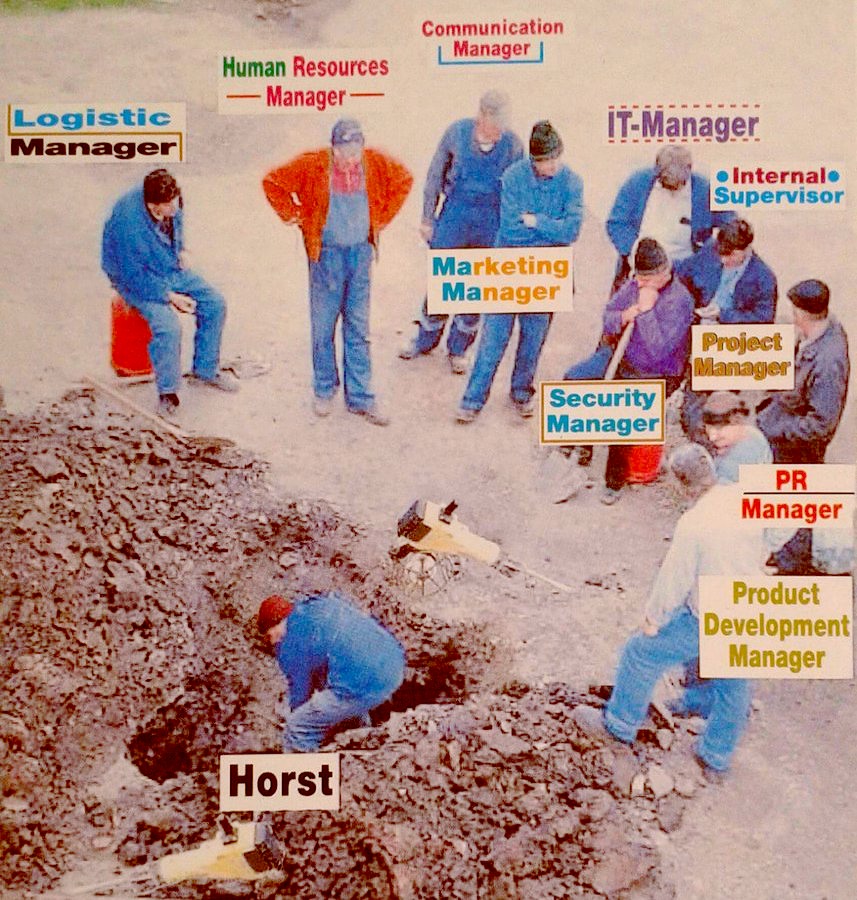Alright, now we know that “good old money” is neither good nor bad and that we are allowed to pile it up it for private purposes. But how do you get that done in a sustainable way? A way where you are not only able to hold the money but you can also multiply it to an extend that you no longer have to worry about it?
Reserves as Personal Reinsurance
We have already learned the first step: Become aware of your personal lifestyle (monthly income vs. expenses) and calculate your current hourly wage. We can refine this step by asking the following questions:
- Contingencies: How much money do I need to keep afloat in an emergency? If possible, I want to be able to continue on the same level as before the emergency, as soon as I have been able to take care of it.
- Planning: What short and medium-term goals do you have and what do you want to acquire for those goals in the near future?
- Priorities: Which of those goals or purchases are necessary to achieve the long-term goal of financial freedom (while still having fun from time to time)?
The first question we also know from the very first article of this bog. We can answer it with a rule of thumb: build up a nest egg that will keep you afloat for about six months, i.e. six times your actual monthly lifestyle.
The second question deals with things that we want to buy in the near future, but which are so expensive that we can’t pay for them out of petty cash. Roughly speaking, this applies to all purchases that exceed the current monthly lifestyle in terms of purchase price, to an extent that it takes more than a month to set aside the necessary amount of money. That could be a new washing machine or a new car, but also a new computer that I need for work.
But we don’t want to focus on new purchases only. Also consider other major expenses that may become necessary in the coming months or years. Homeowners may be familiar with this. Suddenly, the roof gutter starts to leak and you have to order a craftsman. If the repairs turn out to be bigger, a few thousand dollars may go down the drain — literally. Or the car goes in for a routine inspection and it turns out that the exhaust needs to be replaced. For things like that, it is good to have a small financial cushion that you can fall back on if worst comes to worst.
Question Three breaks down these future planned purchases into three categories: necessities, luxuries and knick-knack. What purchases do I definitely need in the near future? What do I want because it motivates me? What can I give up for the benefit of faster progression towards the greater goal?
Once you have answered these questions satisfactory and it’s clear what numbers we have to deal with, then we can start to open a reserve deposit to fund these things. It’s like building up a personal reinsurance. An insurance company steps in when an unexpected, previously insured event occurs and pays for the damage. In return, I pay premiums to the company. The reserve depot works exactly the same. Each month, I sock away some money and transfer it into different accounts until they are filled up to a level I feel comfortable with. If the event I created the account for occurs, I use the money and then I start filling up the account again.
I personally use the following four accounts for my reserve:
- Survival: for emergencies and to keep me afloat if there’s an unexpected drop in income. Sufficiently filled at: Six times my monthly lifestyle.
- Savings: Costly purchases which cannot be paid from petty cash. Sufficiently filled at: A sum has been reached to cover the total planned purchases for the next two to five years.
- Reserve: Reserve for emergencies (repairs, etc.). Sufficiently filled at: A sum has been reached to cover the planned repairs for the next two to five years.
- Fun Account: for motivating luxury, vacation, parties, fun etc. Everything that keeps you motivated. Sufficiently filled at: A sum has been reached to cover the planned expenses / vacation for the next twelve months.
Of course, it’s up to you if you want to do it the same way. Everyone will have their own “sufficiently filled” amounts they feel comfortable with. The important thing is that you maintain a certain discipline. Only plunder the accounts for their very purpose!
Oh yes, and of course it is important to get started. The best thing you can do right now is to write down the schema for your accounts. This doesn’t need to be chiseled in stone. If you haven’t done anything yet to structure your finances, you’re setting a new pattern in your life. Let it mature over a few days or weeks, and from time to time, you can adapt the account structure and their amounts to your situation. But you should take the first step now: take a few minutes to reflect what you have just read and write down which reserve deposits and accounts you need for your financial freedom.
What about debt?
But what do I do if I still have any outstanding debts? Should I pay them off right away? Or should I delay the payback as long as possible? How do I squeeze those debts into the account schema we just heard about? The answer is: it depends. Even debts generate a “return”, which is “just” negative for the debtor. The crucial question is: how big is the monthly interest burden?
In theory, reducing debt is only ecological if there is no investment with a higher return that I could pay into at the moment. For instance, if I have a thriving stock portfolio that generates an annual return of 8-10% and simultaneously there’s a loan to pay off with an annual interest rate of only 5%, I want to delay the repayment of the loan as long as possible. Each dollar that I can spare is better invested into my portfolio. Why? Quite simple: By using the dollar to keep paying off the loan, after one year, I have saved five cents on interest. But if I put it in my portfolio and wait the same time, I pay five cents in interest on the loan while receiving a return of eight to ten cents from the portfolio. I can keep the difference of three to five percent.
There are even people who take advantage of this concept for a living. They borrow money at the lowest possible interest rates and use it otherwise to generate profits. As a matter of fact, this is one of the oldest concepts among banks – and entrepreneurs. They call it investing. It has worked dozens of times, especially when founding a company. Many entrepreneurs with brilliant business ideas are either not willing or not able to start their business without using other people’s money.
But be careful: no matter how many people succeeded, just as many have failed and gone bankrupt because they miscalculated or misjudged their strategy. As the amount of debt increases, so does the risk of not being able to pay the interest burden in case of unexpected events. Here we have the classic risk / return ratio, and everyone should determine that individually for themselves. If you are playing with the idea of going into debt on purpose, you should carefully consider the risks, know exactly what you are doing, and keep track of your account balances and cash flows. So, fasten your seat belt. Step on the gas harder only if you feel secure enough in the driver’s seat.
However, it makes sense to pay off consumer debts as quickly as possible. They usually have the highest interest rates. This includes credit card charges, an overdrawn line of credit on your bank account, or installments on purchased electrical goods. The latter should be avoided in the first place. Cover them with the previously mentioned reserve accounts. This is way cheaper in the long run. Regarding those “extremely cheap” zero-percent financing options you often get offered at your local electronics market, I usually sum up all the monthly installments and compare them with the purchase price when paying immediately. The difference between those two is the net interest rate for the whole loan. It’s the price for not paying everything immediately. If this number is close to zero, then there is no reason why not to stretch your liquidity a little bit — as long as filling out the credit agreements uses up a reasonable amount of time. I usually do not enjoy doing such paperwork.
All other debts – whether it be repayments of student loans, old debts from court cases, or a loan for one’s own home – I would pay off depending on the rate of return. Rule of thumb: If the interest rate is below 2-4%, pay off as slowly as possible. The money can be invested elsewhere with more profit. The difference between the interest on debt and the return of the investment will work in your favor. If the interest rate is higher, pay off as quickly as possible. But not so fast that you can neither increase or refill your reserve accounts, nor have any money left for investments.
Obviously, you’d want to avoid excessive borrowing as a whole. To get back to the crucial question mentioned above: You want to be able to afford the loan as a whole and to pay the monthly installments. In other words, you must be able to make enough money. The installments must become a permanent part of the expenses section of your lifestyle spreadsheet, preferably with a separate heading called “Lending Rates”. Also you should add one more reserve account, with an amount you need to repay the rates — ideally, a little bit more so you have some headroom. If all these factors are taken into account, you will be alright. At best, such a loan will no longer be a burden, and the payback begins to be fun.
Pulling Money Levers
So far so good. But what if I don’t have enough money to fill up these super fabulous reserve deposits? What if I would like to, but I have just enough money to make ends meet? If somehow, at the end of money, there’s too much month remaining.
Essentially, there are two possible ways here. Increase your income or decrease expenses. Unfortunately, there is no lesser evil. Imagine you want to lose some weight. With a diet, it’s similar. In the long run, you can only drop pounds if you burn more calories than you eat or eat less than you burn. Otherwise the body will not break down fat. Unfortunately, these are the limits imposed by physics. With money, it’s exactly the same.
Alright, once this bitter pill has been swallowed, the next question is: what is the best way to do it? Let me deal with both topics, saving and increasing income, one after the other.
Let’s talk about saving first. You have already done most of the work if you did the exercise as described in the chapter about lifestyle. By using the table you created there (you created that table, right?), you have a clear overview outlining your expenses, which in turn helps you to decide where to make cuts. Start with the largest issues and luxuries, before systematically working your way from one category to the next. I bet there are plenty of things that you can cancel. And chances are good that it doesn’t have to be forever.
And by the way: sometimes it can be very exciting to go without something for a while. In my experience, you can enjoy certain things way better if you abstain from them for some weeks or months or maybe even longer. You don’t need to become a frugalist. I have met a few people with that mindset and I think most of them overdo it a little when it comes to saving and restricting. For me, too much quality of life would get lost. But there is one thing they know for sure: how to save money. So if you think it will help you cut down your expenses, a little Google research on frugalism won’t hurt. The people in this community have lots of creative and often useful advice on what and how to cut back.
The second point is way more fascinating than saving, since it has more potential and shares many similarities with investing: increasing your income, or rather your hourly wage. There are just as many tactics and possibilities for this as there are for saving, and I could easily write a whole new series of articles about this topic (if you are interested in such content, feel free to participate in my feedback survey). Therefore, I just want to give you a brief overview on the most important points.
In order to increase my revenue, I have to generate more value for others. This is the very key principle. In this regard, permanent education is the greatest lever. By getting better at what I do, I will improve my performance, which in turn leads to people who are willing to pay me more.
There are many ways that allow you to develop your skills. One of the cheapest option is to check if your employer offers trainings for additional qualifications. Ideally, such a training can be done during your working hours. Also consider visiting evening courses at (community) colleges or (distance) universities, or you can read books on the subjects you want to expand your knowledge on your own.
A second lever that should not be underestimated is marketing yourself. At first, you should get an overview of the situation. Compared to others in your field, how much do you currently earn? And if you come to the conclusion that you are lagging behind, then it is about time you catch up with the competition. For instance, by negotiating a raise. For that, there’s one important point to consider: it is not of importance to your boss what you need for yourself, but what you contribute to the company. When discussing a raise, most employees think about what they need (more money for a new car, to feed the children, or to pay off the loan for their house). But the boss usually doesn’t care. What counts in a salary negotiation is the performance for the company. Where have you been able to add value to your company most recently? Or how can you do so in the near future? Are there inefficient processes somewhere that you could improve? Any promising projects that you can take on? These are the questions to ask yourself in order to show your boss that you add more value than you get paid for.
In general, the more responsibility you can take over in your job, the more you get paid. There is a reason why salaries earned in middle management are often better than those of a senior technician. The manager is in charge of an entire department of technicians, while administering budgets and being responsible for keeping his department up and running. The technician or engineer provides the expertise and “just” implements. Please don’t get me wrong. I don’t want to blacken the contribution of a techie, on the contrary. I myself am one of those and nothing would work without the boys. But we definitely need the managers. Even if the profession tends to have a somewhat less favorable reputation, especially compared to a technician. Fact is, when working as an engineer somewhere “down” in development, the potential is capped as far as a high salary is concerned. A top manager has more opportunities and possibilities to earn more money. He can reach other dimensions and magnitudes.

Thus, if you realize that you have reached a dead end in terms of salary, you still have the option to change jobs. You might even be able to do that within the same company. There may be another department or another location looking for someone right now. Or maybe my current job annoys me so much that I would rather do something else, maybe after some additional training, so I can take a leap into higher qualified dimensions.
None of this has to be the case and I hope you have already found your dream job that allows you to thrive and earn enough money. However, I still want to mention the possibility. It exists and can be very promising. But if you find yourself in the dire situation of chronically having not enough money, pick at least one of these numerous possibilities and go with it. A quick Google research is quite useful when it comes to defining the first steps to take.
And if everything else fails and there are no surpluses in sight to fill up your reserve accounts soon, then there is always the alternative of start out investing with just little or even completely without money. You can always invest on paper. Start by learning the ropes and later, once you have enough dough, pay less to learn.
This works particularly well when trading stocks. There are plenty of websites where you can create a free sample portfolio and buy stocks or other securities with toy money. Wikifolio is a good example, as they only trade with genuine prices you also would get on the real stock market. It’s a great playground to gain experience, and has become one of the main pillars of my financial freedom.
Cash Flows – Where to Put the Dough?
Aaand we’re almost done with the topic. If you have managed to generate a surplus (either by increasing your hourly wage or reducing your lifestyle), then use this excess money to invest. Do this once you have sufficiently reduced the previously mentioned debts and sufficiently filled your reserve accounts. What is sufficient? This lies in the eye of the beholder. By now, everyone should be able to calculate that for themselves.
The brave start investing earlier in order to create a nice flow. That makes it easier to acquire knowledge in parallel and might increase motivation. After all, it can be quite frustrating if you have to “slave away” for 20 years until you manage to pay off your real estate loan, and finally you can start investing. We have learned that it can take one, two, maybe even three decades before we can live off our investments. Reducing your debts first and starting to invest afterwards, that can quickly add up to 40-50 years in total. If you start investing in your mid-30s, you will eventually be finished at around 80 years of age. At least your descendants will enjoy a substantial fortune — as long as they have learned to manage and maintain it.
All jokes aside. Needless to say, it is better to reduce debts and build up wealth in parallel. Assume for a moment, you start with $100,000 in debt and $100,000 in assets. Then, your overall balance would be zero. But you would still have a certain sum of money that you can work with and that can grow. As mentioned before, the difference between the interest on debt and the return on investment works for you if you invest wisely. This can be even more successful than starting completely from scratch.
Finally, one last word about investments: in the beginning, you should focus on a single main investment until you have acquired enough knowledge and experience that this mainstay runs more or less automatically. Once that has been done, you should concentrate on a second investment which is independent from the first one, and can be built up in parallel. For instance, a property for rent in addition to a stock portfolio. That way, you are able to spread the risk. If one investment is experiencing a crisis, the other will continue to yield a steady return. Two mainstays are good, three are better. Four or more are great. However, the latter only makes sense if the additional time necessary to learn, set up and manage another main pillar is reasonable.
Conclusion
If you have not done so already, determine what your major expenses will be for the next few months and decide if there will be any specific categories that would require reserve accounts. Then come up with a schema for the various accounts and plan the monthly amounts that you want to set aside as well as the maximum level that you want to accumulate in the accounts in total. If you have debts, think about the repayment speed (depending on the interest on debt: consumer debts and debts with high interest should be paid off quickly, debts with low interest rates at a slower pace). Also you should talk with your banker to check if the loan agreement can be adapted to these ideas.
If you have never done this before, you can use the schema I described above as a guide. Don’t worry too much about the exact numbers. Concentrate on the magnitudes instead (do I need a few hundred or a few thousand euros in an account?). Also get started. Once you have gained some experience and feel confident about your decisions, the schema as well as the numbers can be adapted. Getting started and doing something which might be not 100% correct in the first place is always better than staying where you are.
With that, you’ll have a solid foundation for your financial freedom. What you learned so far is like the speedometer and distance sensors in a car combined. It keeps you on track financially and ensures that you don’t skid even when things get a little rough. Finally, there is only one thing left to do: pick your first investment and get started.

And if you are now wondering which investment might be suitable for you: let’s continue with the last article from the “Basics” series, which is about…





